This December, Science Borealis is excited to feature a series of stories developed for a story-telling event held at the joint conference of the Society of Canadian Ornithologists, Association of Field Ornithology, and Wilson Ornithological Society in July 2024. These stories were prepared with the help of Borealis Blog editors and polished for oral presentation by coaches from The Story Collider. We hope you enjoy these behind-the-scenes glimpses into the lives of ornithologists!
By Katja Kochvar
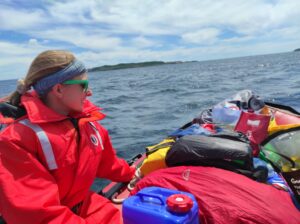
On my way to Gull Island in our bright orange zodiac boat, decked out in a bright orange survival suit! Image: Pierre-Paul Bitton.
When I arrived on the shores of Gull Island on a cool day in late May, I had no idea what I was in for. My eyes, ears, and nose were alive from the instant our zodiac boat touched the slick rocky landing. The sight of thousands of seabirds was nothing short of impressive; Black-legged Kittiwakes circling above, Herring Gulls and Atlantic Puffins dotting the grassy slope, and Common Murres resting on the water. The sound was remarkable, a cacophony of shrieking and wing-beating. But it was the smell that I’ll never forget, a lovely mix of salty sea spray and the unmistakable dead fishy smell of guano.
I had come to Newfoundland just five months prior to begin a Master’s of Science program at the Memorial University of Newfoundland. The position was in Pierre-Paul Bitton’s Visual Ecology Lab, where I would be investigating the potential adaptive function of the Atlantic puffin’s colorful bill. In other words, we wanted to know why puffins are so pretty. Pierre-Paul was a relatively new faculty member, and I, along with my fellow students Amy and Raul, were his first team working with puffins.
Of the three of us, I stood out as the most ill-prepared, unqualified, and inexperienced member of the team. Amy had 10 years of seabird fieldwork under her belt, having led projects on murres, terns, and more. Raul already had worked with Atlantic puffins during his recent stint in Iceland. Me? I was fresh out of undergrad, where I had done an honors thesis on song sparrows – a bird that could not be more different from an Atlantic puffin. While I had done some fieldwork here and there, I had no hard skills that would benefit me in this new role. To say I felt imposter syndrome is a gross understatement. I tried to keep my insecurities at bay by reassuring myself that I was a quick learner.
As I scaled Gull Island for the first time, doing my best to balance on the grassy knolls padding each puffin burrow, I wasn’t so sure I could be a quick learner. But there was no way but up the cliff, so I kept my head down and focused on mastering this first skill: walking without collapsing a burrow.
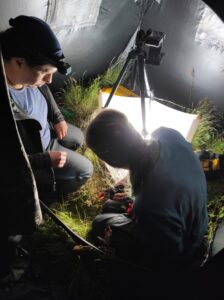
My colleague and mentor, Amy (left), guiding me (right) on how to properly hold my first Atlantic puffin. We were preparing to take images for my Master’s thesis project. Image: Antoine Morel.
Over the next several weeks I slowly gained my footing, thanks to Amy’s close mentorship. Our most grueling task was collecting data on individual puffins. The process is a little crazy, so let me give you a brief overview. The most straightforward way to catch a puffin is to carefully extract them from their burrow. To catch them most off-guard, we waited until a comfortable blanket of darkness had fallen before taking to the slope. There, we split into grubbers and banders, responsible for capturing and banding the puffins, respectively.
Both roles were fraught with challenges. The grubbers had to face the unknown, reaching a bare arm along twisting burrows, hoping to feel a stray feather or for the unlucky ones, the sharp grip of a bill clamping down on a finger! In contrast to grubbing, the challenge with banding stared you head-on in the form of a reddish-orange bill and orange feet with pointy claws. Handling a puffin while attaching an identification band to the leg, taking a blood sample from the brachial vein, and snapping pictures of the bill was a feat of nature. I quickly realized that nasty bites and scratches were just part of the job.
By mid-July, I was feeling pretty confident about my abilities in the field. I could grub, I could band, and while I still had room to improve, I had caught on fast enough. But the ultimate test was yet to come. Amy’s project focused on the genetic structure of puffins across the island, which meant: 1) we needed to traverse the entire island, a long trek made longer with our heavy equipment, 2) we needed a big sample size, so 25-30 puffins a night was the bare minimum, and 3) we needed to do it all in one 4-day stretch. For the first two days, Pierre-Paul and another team member would be joining us, but for the last two days, it would just be Amy and me. We almost always worked in teams of at least 3-4 people and rarely captured more than 20 birds in a 3-hour shift. Capturing 30 birds nightly as a team of two was borderline insanity. I privately wondered whether we were truly up to the task, but outwardly displayed a false confidence that I hoped would dispel Amy’s fears of depending on a novice for the fate of her project.
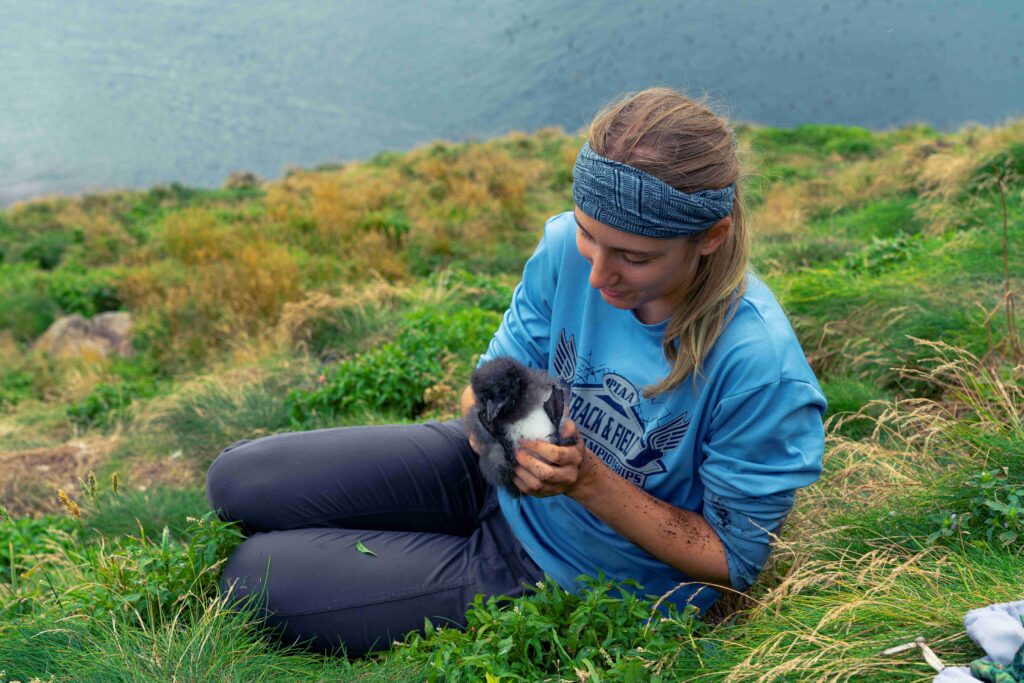
Grubbing for puffins – including their chicks – often involved reaching an entire arm into a burrow and hoping for the best! Image: Raul Zabala Belenguer.
The first two nights ran smoothly. I mainly assisted Amy in the banding tent, while Pierre-Paul acted as expert grubber, stunning us with his speed and efficiency at capturing puffins. At one point, he returned with two puffins, one in a bag and the other in his free hand! Was he mad?! I had never seen anyone grub two birds at once. I felt a tinge of jealousy creep upon me. I was a decent grubber, but I was fairly certain I could never do something like that.
But there was no time for self-doubt – now was my moment to try my hand at being expert grubber. For the last two wild nights, I was solely responsible for capturing each and every puffin. The first night went surprisingly well. We may have been working until 4:00am, but we captured nearly 30 birds, right on target. On the second night, as I was returning with what would’ve been our tenth puffin of the evening, I spotted the familiar outline of an adult puffin at the entrance to another burrow. Without hesitation, I reached my arm down and carefully snatched him up by the shoulders before he could retreat.
I paused, staring in amazement at my two hands – my left with a puffin in a bag, and my right firmly gripping the now eleventh puffin. Recognition of the significance of the moment dawned on me as I recalled my supervisor, Pierre-Paul, returning just days ago in the exact same state, with a puffin in each hand. I remembered how wistful I felt, how in awe I was by his field savviness and expertise. As I returned to share the news with Amy, grinning from ear to ear, I felt as though I had experienced a rite of passage of some sort. In that moment, I finally felt like the expert grubber that I was. And I realized that skills or no skills, I was ready for whatever the future might hold.
Now, several years later, I have just completed the first year of my PhD at Princeton University, where I’m studying Broad-tailed Hummingbirds – a bird that could not be more different from an Atlantic Puffin. Once again, I have no hard skills from my puffin work that have served me in the field with hummingbirds. Capturing hummingbirds doesn’t involve grubbing them out of burrows and handling them is a much gentler process than gripping a puffin. However, I have gained other transferable skills, namely confidence, patience, and a deep trust in myself that whatever I need to do, I’ll figure it out. Because as it turns out, I’m a pretty quick learner.
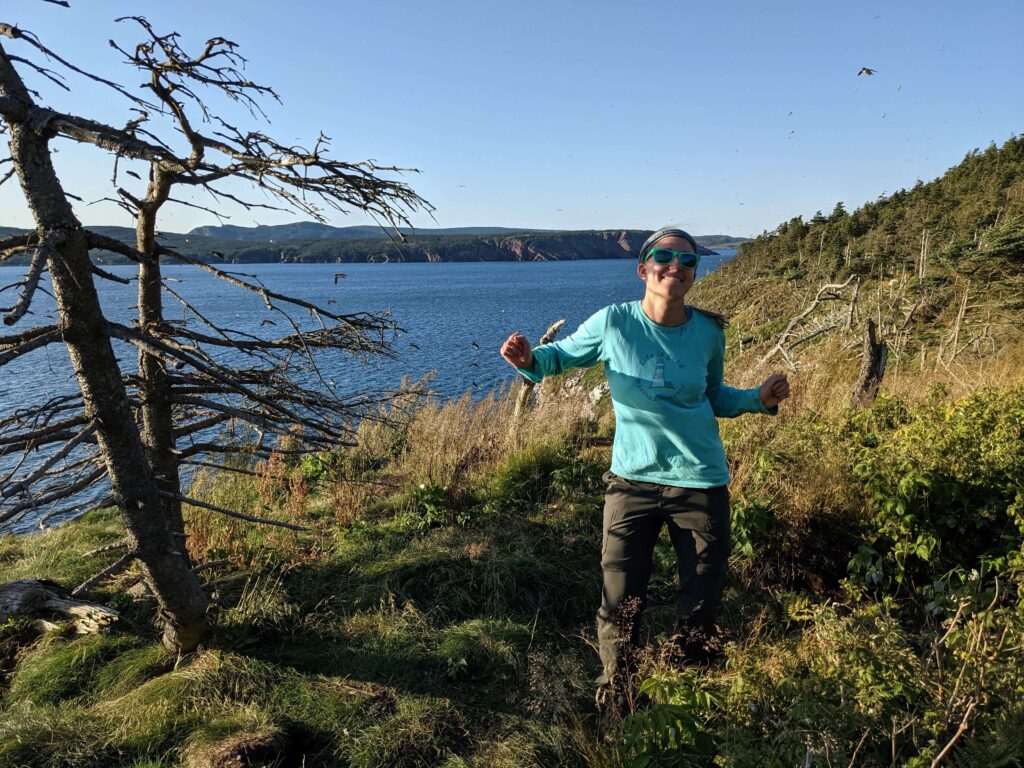
Triumphant, after a great first field season working with Atlantic Puffins on Gull Island. Photo: Raul Zabala Belenguer.
Feature image: View from Gull Island of Atlantic puffins taking to the sky on a windy day. Image: Raul Zabala Belenguer.

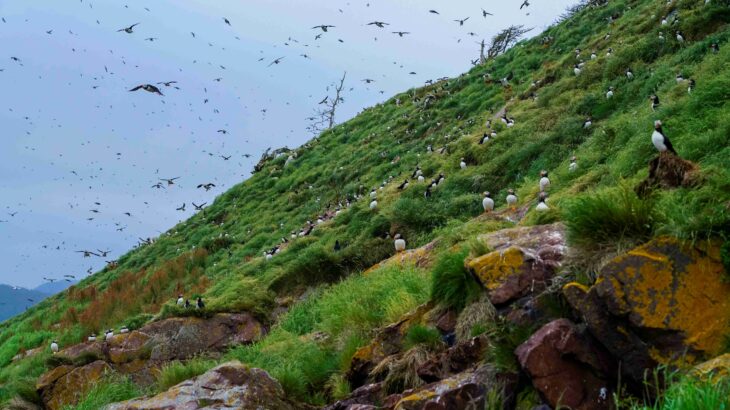



xz7g9o
fd00fz
0lzl2c
vt50bw
lqcsdg